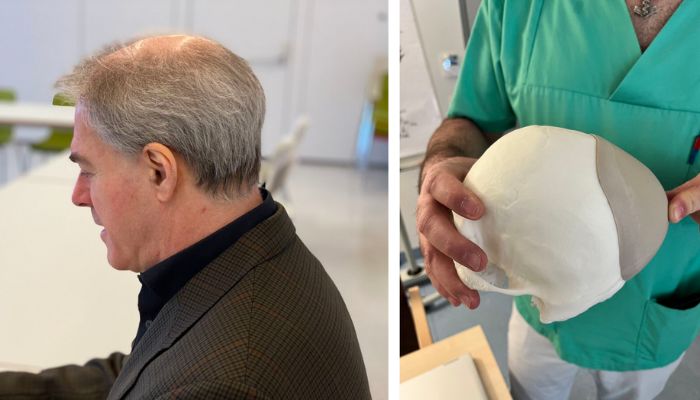With the use of additive manufacturing in the medical field, it is becoming increasingly clear the technology can contribute to a better quality of life. Take, for example, the unprecedented operation at the University Hospital of Salzburg in Germany. Surgeons successfully implanted a 3D-printed cranial prosthesis in a patient – one of the first in Europe.
Craniostenosis in infants is a condition that causes skull deformities such as craniostenosis. This occurs when bones fuse too soon, leading to a 55-year-old victim. It is not the slow growth of bones that causes the problem, but the brain’s rapid growth in the first year. This can lead to higher intracranial pressure that can cause blindness and mental disability. Due to the abnormal skull appearance, this disease can cause psychological stress for patients. 3D printing is increasingly being used in these kinds of dangerous operations.

Mr. Trummer (center), received a prosthesis made of 3D printing at the University Hospital of Salzburg
Professor Alexander Gaggl, head of the University Clinic for Oral and Maxillofacial Surgery (MKG) at the Salzburg University Hospital, explained: “From the beginning, we planned to replace the missing occiput by a prosthesis. The scalp is extremely tight and barely movable, which we discovered when we examined it..” For this reason, a plastic balloon was implanted under the patient’s scalp one year before the prosthesis was transplanted. The balloon was made larger by adding a solution of saline to it during treatment.
The first time that the Salzburg clinic had ever transplanted a 3D-printed prosthesis was in the year 2000. Another one was developed at the same time. To build the model on the computer, CT images were used. This scanner makes it possible to obtain sliced imaging of the different parts of the body as well as to visualize tissues of different densities. The Kumovis R13D printer was used for the fabrication of the prosthesis. This machine met the institution’s requirements, as the system guarantees a sterile process. It was printed using PEEK. According to the clinic’s estimates, the manufacturing process would have taken around 10 hours. Six weeks after the operation and with the wounds largely healed, the patient Rainer Brummer was satisfied with the result: “I don’t feel like I have an implant in my head, I feel like I have a completely “normal” head now. This is the realization of a lifelong dream for me.” The University Hospital of Salzburg in Europe is a pioneer in 3D printing in hospitals. After a lengthy process in which all guidelines were followed, the clinic was able to print and implant implants.

What do your thoughts on the 3D printed prosthesis Let us know in a comment below or on our LinkedIn, Facebook, and Twitter pages! Don’t forget to sign up for our free weekly Newsletter here, the latest 3D printing news straight to your inbox! You can also find all our videos on our YouTube channel.
*All Photo Credits: Salzburg University Hospital


